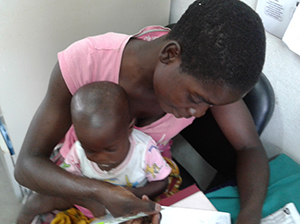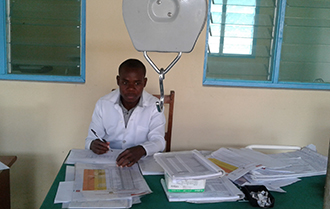
Mr. Muchanga, FANTA Senior Technical Officer for Nutrition. (Photo by Fatima Mucavele, FANTA/Mozambique)
In Mozambique, each child flagged as malnourished during routine growth monitoring at a well-child visit must immediately be referred for an at-risk-child visit to determine whether the child is moderately or severely acutely malnourished. However, based on a baseline assessment and visits to health facilities in Zambézia Province’s Nicoadala district, the Food and Nutrition Technical Assistance III Project (FANTA) observed that children found to be malnourished at well-child visits were not being appropriately registered or referred for evaluation for possible acute malnutrition.
“We saw that the staff needed a way to help keep malnourished children from falling through the cracks,” said Baraca João Muchanga, FANTA Senior Technical Officer for Nutrition. In addition, the solution had to be simple and easy to use so as not to overburden the health workers, he noted.
In consultation with health staff in Nicoadala, FANTA developed a daily registry form to register and refer malnourished children from the well-child clinics to the at-risk-child clinic. In October 2015, well-child staff in the Nicoadala health facility began using the form to improve referral of malnourished children and track children through the referral process.
The form is “very useful for following up patients from one sector to another,” said Claudia Alfredo Jose, the Nicoadala Well-Child Sector Focal Point. Moreover, “patients are accompanied from the well-child clinic to the at-risk-child clinic so they do not get lost in the health facility and receive the needed care,” she added.

Ms. Lemos and her daughter Naira. (Photo by Baraca Muchanga, FANTA/Mozambique)
In one case last July, Ninicha Andale Lemos brought her 14-month-old daughter, Naira, to the well-child clinic at the Nicoadala health facility. Naira was ill and had swollen feet. “I was desperate,” said Ms. Lemos, who had walked 7 kilometers to the facility. Using the registry form, a nurse referred Ms. Lemos to the facility’s at-risk-child clinic and walked with her to the clinic. Naira was diagnosed with malnutrition, began treatment right away, and steadily improved. “Now she is better,” Ms. Lemos said. Naira was discharged after receiving proper treatment over seven weekly visits to the at-risk-child clinic.
The registry tool also enables well-child staff to more easily check on the treatment outcomes of the children they referred, which provides staff with helpful feedback on their referral decisions.

Mr. Caetano, Nutrition Focal Point at the Nicoadala health facility. (Photo by Baraca Muchanga, FANTA/Mozambique)
“This is good because now we know what is the outcome of the patients identified with undernutrition,” said Edgar Arthur Caetano, the Nutrition Focal Point at the Nicoadala facility.
In addition, using the form can help health workers see whether cases of acute malnutrition are increasing in the community, said Mr. Muchanga.
Drawing on the Nicoadala facility's experience, FANTA-supported health facilities in Nampula province have adopted the tool. In addition, reflecting the form’s usefulness, the Ministry of Health has developed a national registry book for well-child clinics that includes referral of malnutrition cases to the at-risk child clinics or to hospitals. The registry book is being tested in Nicoadala. “We are very happy that the referral mechanism may be expanded throughout the country,” said Mr. Muchanga. “This is a very simple thing that can save the lives of many children.”


